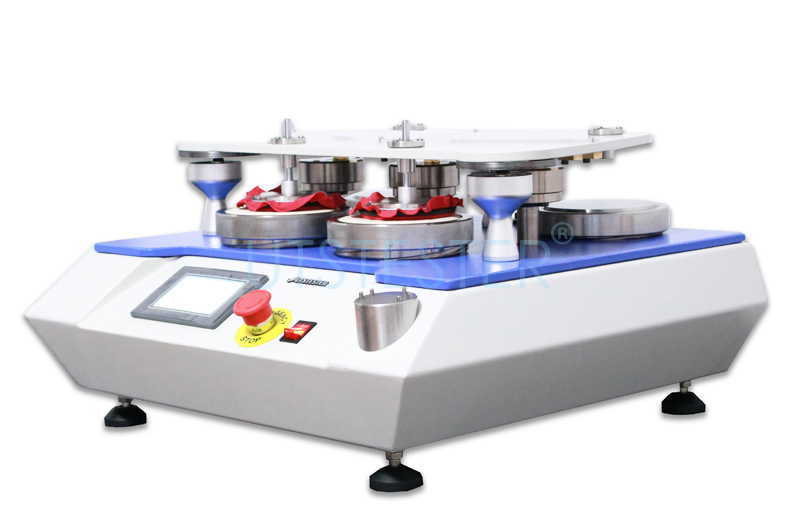 +86 152 6060 5085
+86 152 6060 5085
 +86 152 6060 5085
+86 152 6060 5085
Blog
Catalog
1 Scope
1-1 This method is suitable for judging the ability of fabrics to resist pilling and other changes in surface properties. The instrument used is the Martindale tester, and this method is suitable for various knitted and woven fabrics.
1-2 This method is not suitable for fabrics with a thickness exceeding 3mm (0.125in).
1-3 Specimens may be washed or dry-cleaned before testing.
2.Principle
Determine the pilling of the fabric and other related changes on its surface. For example, use a testing instrument to simulate the pilling that occurs during normal wearing. Under slight pressure, place the sample mounted on the sample clamp against the fabric itself on the grinding table. Rub each other in a certain geometric pattern, and then compare and rate the ground sample with the standard sample.
3. Equipment and reference materials
3-1 Martindale Tester.
3-2 Standard felt: weight 750±50g/㎡ (22±1.5oz/yd2), thickness 3±0.3mm (0.12±0.01in).
3-3 Polyurethane foam: density 29-31kg/m3, thickness 3±0.01mm.
3-4 Rating box: Cool white fluorescent lamp, holder for placing test samples and standard rating samples.
3-5 Standard internal pilling detection cloth: Save fabrics with known pilling levels according to actual conditions for checking the performance of the instrument.
3-6 Rating sample photos: Each set is about 105mm wide. The degree of pilling is indicated from "very serious pilling" to "no pilling", and is numbered from 1 to 5.
3-7 Sampler: There are two types of diameter: 38mm (1.5in) and 140mm (5.5in).
3-8 Water washing equipment (if necessary).
3-9 Dry cleaning equipment (if required).
4. Sample preparation
4-1 Unless there are special instructions, samples need to be washed or dry-cleaned before taking the test sample.
4-2 Use two samplers to take four 140mm and 38mm samples from the sample to be tested.
4-3 The principles that should be when taking samples are: take samples immediately on the sample. If the sample is clothing, take samples from different parts; each sample does not contain the same yarn; do not take samples from wrinkled or weaving defects; Sampling must be done at a distance from the fabric that exceeds 1/10 of the entire width of the fabric.
4-4 The sample to be tested is allowed to stand for at least 4 hours under constant temperature and humidity conditions of 21±1℃ and 65±2%RH.
5. Test procedures
5-1 All testing processes must be completed under standard atmospheric pressure conditions.
5-2 Place a piece of felt with a diameter of 140mm and a sample of 140mm on each grinding table, use a heavy hammer to flatten the sample and felt (make sure there are no wrinkles, repeat the above process if they are uneven), and fix the ring. .
5-3 Place the 38mm (1.5in) diameter specimen facing outward and the polyurethane foam on the specimen clamp in sequence.
5-4 Place the sample clamp on the grinding table, and insert the mandrel into the sample clamp, that is, a pressure of 3kpa is applied to the test sample on the grinding table.
5-5 The counter needs to be adjusted to zero position, preset for 100 turns, start the machine, and the instrument will automatically stop after 100 turns.
5-6 Place the ground sample in the rating box.
5-7 Compare the rating photo with the sample, and rate with a bird's eye view close to 45°. When the surface effect after grinding is between two levels, it can be rated, such as 3.5 or 2.5.
Note: 5 - No pilling
4 - Slight pilling
3 – Moderate pilling
2 - severe pilling
1 - Very severe pilling
5-8 Calculate the average of the rating results.
6. Report
6-1 Test method adopted: ASTM D4970, description of specimen, and sampling method.
6-2 The grade and average value of each test sample.
6-3 If the sample has been washed, the washing conditions must be reported.
6-4 Number of runs.
6-5 Type of rating box, rating sample card used.

Email: hello@utstesters.com
Direct: + 86 152 6060 5085
Tel: +86-596-7686689
Web: www.utstesters.com